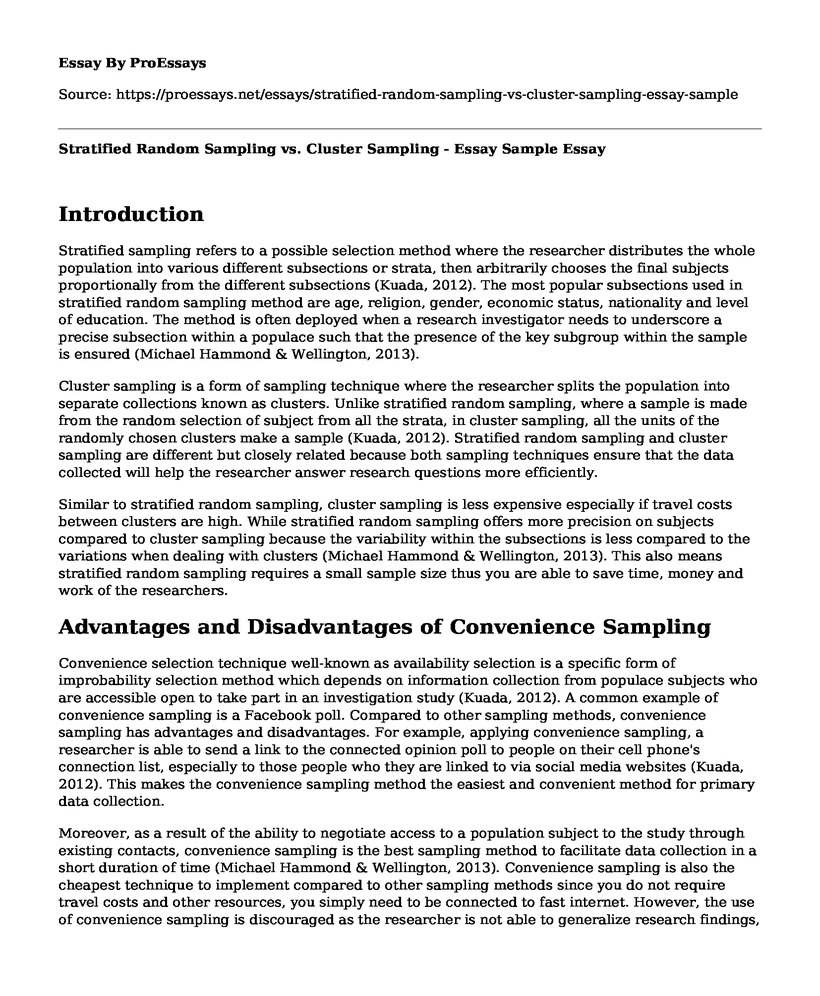Introduction
Stratified sampling refers to a possible selection method where the researcher distributes the whole population into various different subsections or strata, then arbitrarily chooses the final subjects proportionally from the different subsections (Kuada, 2012). The most popular subsections used in stratified random sampling method are age, religion, gender, economic status, nationality and level of education. The method is often deployed when a research investigator needs to underscore a precise subsection within a populace such that the presence of the key subgroup within the sample is ensured (Michael Hammond & Wellington, 2013).
Cluster sampling is a form of sampling technique where the researcher splits the population into separate collections known as clusters. Unlike stratified random sampling, where a sample is made from the random selection of subject from all the strata, in cluster sampling, all the units of the randomly chosen clusters make a sample (Kuada, 2012). Stratified random sampling and cluster sampling are different but closely related because both sampling techniques ensure that the data collected will help the researcher answer research questions more efficiently.
Similar to stratified random sampling, cluster sampling is less expensive especially if travel costs between clusters are high. While stratified random sampling offers more precision on subjects compared to cluster sampling because the variability within the subsections is less compared to the variations when dealing with clusters (Michael Hammond & Wellington, 2013). This also means stratified random sampling requires a small sample size thus you are able to save time, money and work of the researchers.
Advantages and Disadvantages of Convenience Sampling
Convenience selection technique well-known as availability selection is a specific form of improbability selection method which depends on information collection from populace subjects who are accessible open to take part in an investigation study (Kuada, 2012). A common example of convenience sampling is a Facebook poll. Compared to other sampling methods, convenience sampling has advantages and disadvantages. For example, applying convenience sampling, a researcher is able to send a link to the connected opinion poll to people on their cell phone's connection list, especially to those people who they are linked to via social media websites (Kuada, 2012). This makes the convenience sampling method the easiest and convenient method for primary data collection.
Moreover, as a result of the ability to negotiate access to a population subject to the study through existing contacts, convenience sampling is the best sampling method to facilitate data collection in a short duration of time (Michael Hammond & Wellington, 2013). Convenience sampling is also the cheapest technique to implement compared to other sampling methods since you do not require travel costs and other resources, you simply need to be connected to fast internet. However, the use of convenience sampling is discouraged as the researcher is not able to generalize research findings, hence resulting in biases and high sampling error (Kuada, 2012). Because of the high level of bias in data collection the researcher has little credibility.
Qualitative vs. Quantitative Methods of Research
Qualitative research is mainly investigative research. It is used by researches who seek to understand the fundamental reasons, thoughts, and inspirations. It offers perceptions into the challenge or aids in developing concepts or theories for potential quantitative research (Michael Hammond & Wellington, 2013). Qualitative data gathering techniques differ using formless or semi-structured methods. The most popular methods include focus assemblies, individual consultations, and contribution or annotations. The sample size is usually insignificant, and respondents are chosen to accomplish a specific quota.
Quantitative method quantifies a challenge as a form of making numerical facts or facts which can be changed to usable information. Quantitative research quantifies thoughts, approaches, beliefs, habits and other variable factors. The quantitative data collection method is more structured compared to the qualitative collective method as it uses measurable data to articulate proofs and unearth patterns in research. Most common quantitative data collection methods include- face-to-face interviews, telephone interviews, online polls, mobile surveys, and systematic observations.
References
Kuada, J. (2012). Research Methodology: A Project Guide for University Students. New York: Samfundslitteratur.
Michael Hammond, & Wellington, J. (2013). Research Methods: The Key Concepts. New York: Routledge.
Cite this page
Stratified Random Sampling vs. Cluster Sampling - Essay Sample. (2022, Nov 30). Retrieved from https://proessays.net/essays/stratified-random-sampling-vs-cluster-sampling-essay-sample
If you are the original author of this essay and no longer wish to have it published on the ProEssays website, please click below to request its removal:
- Critical Analysis of Bag of Bones Using Literature Criticism
- Film Criticism: Strangers on a Train and Run Lola Run
- Ways Basic Statistics Helps in Research Paper Example
- Central Limit Theorem in Statistical Analysis Paper Example
- Mixed Research Methodology: Bridging the Limitations of Quantitative & Qualitative Research - Essay Sample
- Research Methods in Health Care
- Paper Example on WHA: Evaluating Strategic Options Using TOWS Matrix







